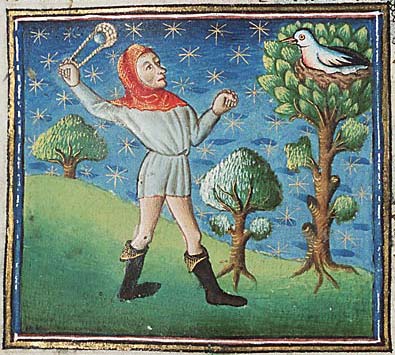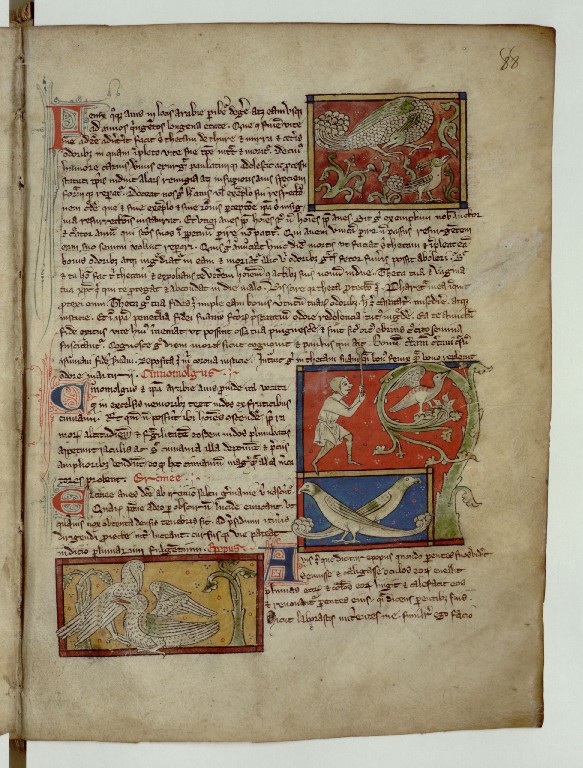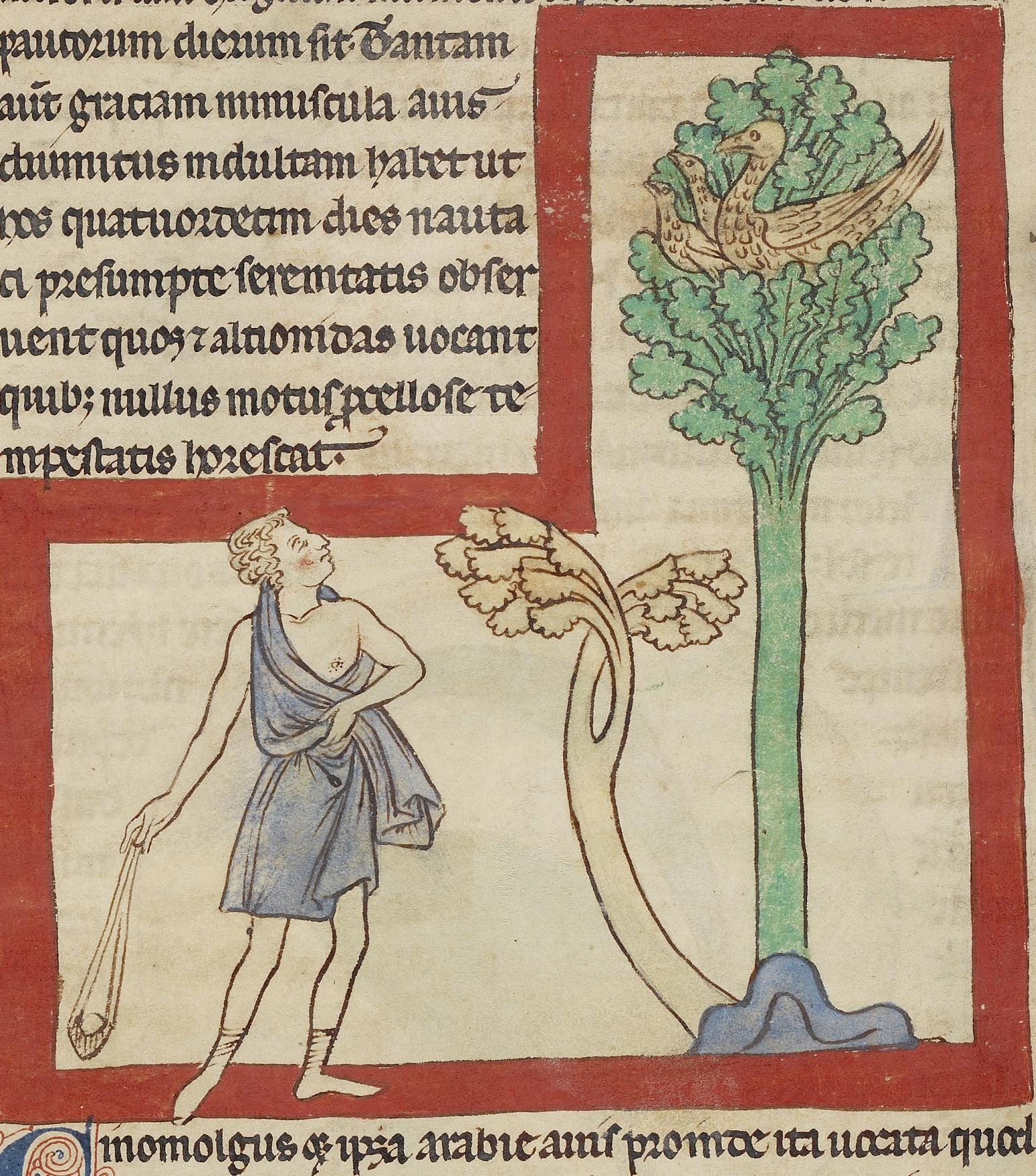Отдышись, Странник. От работы даже кентавры дохнут.
Bestiary.us
энциклопедия вымышленных существБыстрый переход
- Портал им.Киплинга Собрание сказок, поэтически объясняющих происхождение той или иной особенности животных, например "откуда у верблюда горб", "почему у слона длинный хобот", или "с чего б это вдруг кошки и собаки не ладят".
- Городские легенды Cовременная разновидность мифов, как правило, короткие, и, на первый взгляд, правдоподобные (хотя обычно не соответствующие действительности) истории, опирающиеся на современную техническую и общественную реальность, обычно затрагивающие глубинные проблемы и страхи современного общества.
- Средневековые бестиарии Бестиарии практически составляли особый жанр в средневековой литературе, совмещавший в себе черты естественнонаучного сочинения, теологического трактата и художественных произведений, и рассказывающий нам о представлениях средневековой Европы о животных и чудовищных племенах.
Киннамолг
Киннамолг — чудесная "коричная" птица средневековых бестиариев, чьи гнезда ценились дороже бриллиантов
Cinnamolgus — is Arabian bird which makes its nest from the fruits of the cinnamon tree
Киннамолг — чудесная "коричная" птица средневековых бестиариев, чьи гнезда ценились дороже бриллиантов
Cinnamolgus — is Arabian bird which makes its nest from the fruits of the cinnamon tree
Киннамолг — чудесная "коричная" птица средневековых бестиариев, чьи гнезда ценились дороже бриллиантов
КиннамолгЧудесная "коричная" птица средневековых бестиариев, чьи гнезда ценились дороже бриллиантов по-русскиCinnamolgusIs Arabian bird which makes its nest from the fruits of the cinnamon tree in english
Cinnamologus —
Cinnamulgus —
Cinomolgus —
Кинамонъ —
Коричник —
В европейских средневековых бестиариях, а также в "арабском фольклоре птица, которая вьет гнезда на макушках деревьев. Охотятся на него потому, что свое гнездо киннамолг вьет из весьма ценной древесины, которая гораздо ценнее бриллиантов" (216: с.582).
О птице, вьющей гнезда из корицы, писали Геродот, Плиний, Аристотель, Солин, Исидор Севильский, Бартоломей Английский:
"Корицу они* собирают еще более удивительным способом. Где она растет и какая земля порождает это растение, они и сами не знают. Иные утверждают (и они, вероятно, правы), что корица растет в тех краях, где был воспитан Дионис. По их рассказам, большие птицы приносят эти сухие полоски коры, которые у нас зовутся финикийским именем “кинамомон”. А приносят их эти птицы в свои гнезда, слепленные из глины, на кручах гор, куда не ступала нога человека. Так вот, для добывания корицы арабы придумали такую уловку. Туши павших быков, ослов и прочих вьючных животных они разрубают сколь возможно большими кусками и привозят в эти места. Свалив мясо вблизи гнезд, они затем удаляются. А птицы слетаются и уносят куски мяса в свои гнезда. Гнезда же не могут выдержать тяжести и рушатся на землю. Тогда арабы возвращаются и собирают корицу. Собранную таким образом корицу из страны этих арабов вывозят затем в другие страны."
Геродот "История", Книга Третья "Талия", 111 (84)
"There is a bird of Arabia called the cinnamolgus which makes its nest out of cinnamon twigs; the people of that country knock the birds down with lead-weighted arrows, and use them for trade."
Плиний "Natural History", Book 10, 50 (*)
Cinnamolgus et ipsa Arabiae avis, proinde ita vocata quod in excelsis nemoribus texit nidos ex fruticibus cinnami: et quoniam non possunt ibi homines conscendere propter ramorum altitudinem et fragilitatem, eosdem nidos plumbatis appetunt iaculis, ac sic cinnama illa deponunt, et pretiis amplioribus vendunt; [eo] quod cinnamum magis quam alia mercatores probent.
Isidori Hispalensis Episcopi Etymologiarum Sive Originum, XII.7.23 (88)
"Коричник (cinnamolgus) — тоже аравийская птица. Названа она так потому, что в кронах высоких деревьев укрывает она гнезда, сплетенные из веточек корицы (cinnamus), и люди не в силах добраться до корицы из-за высоты ветвей и их хрупкости обстреливают эти гнезда свинцовыми дротиками и так добывают корицу и продают ее за огромные деньги потому, что эта корица ценится купцами больше всякой другой."
Исидор Севильский "Этимологии", Книга XII "О животных",
Глава 7 "О птицах", 23 (118: с.338)
"Of Cannel and of Cassia men told fables in old time, that it is found in birds' nests, and specially in the Phoenix' nest. And may not be found, but what falleth by its own weight, or is smitten down with lead arrows. But these men do feign, to make things dear and of great price; but as the sooth meaneth, cannel groweth among the Trogodites in the little Ethiopia, and cometh by long space of the sea in ships to the haven of Gelenites. No man hath leave to gather thereof tofore the sun-rising, nor after the sun going down. And when it is gathered, the priest by measure dealeth the branches and taketh thereof a part; and so by space of time, merchants buy that other deal."
Бартоломей Английский "De proprietatibus rerum", book 17 (*)
По свидетельству славянского бестиария, в Аравии есть чудесная птица, которая вьет гнезда на коричных деревьях. и зовут эту птицу "кинамонъ":
"Кинамо́нъ пти́ца ѩко ма́лый и па́въ обаче хвостъ его е́сть мнѣи, и вид его бѡлый и носъ его желтыiи ѩко же ѩстребъ... Гнѣздо [устраивает] от древес кинамѡновых, сирѣчь коричныхъ"
"Славянский бестиарий" (102: c.142)
В литературе
— И посох, конечно.
— Что, какой-то особенный? — удивился я.
— Разумеется, — улыбнулся он. — Навершие должно быть вырезано из кинамона.
— А что это? — удивился я. Я ничего даже краем уха не слышал об этом.
— Это такое дерево, — любезно пояснил маг. — Где оно растет — никому не известно.
Он с удовольствием рассматривал, как удлиняется мое лицо и продолжил:
— Но есть такая замечательная птичка, которая называется Киннамолг. Она вьет гнезда из ветвей этого дерева. Живет она в наших замечательных лесах, в самой чаще. Как ты понимаешь, эти гнезда ценнее многих бриллиантов. Птицу выследить вполне возможно. Достанешь одно такое гнездышко — и себе посох сделаешь, и обогатишься так, что не только на обучение хватит, но еще и останется.
Кирилл Елохин "Магия — наше всё!"
Still more wonderful is the mode in which they collect the cinnamon. Where the wood grows, and what country produces it, they cannot tell — only some, following probability, relate that it comes from the country in which Bacchus was brought up. Great birds, they say, bring the sticks which we Greeks, taking the word from the Phoenicians, call cinnamon, and carry them up into the air to make their nests. These are fastened with a sort of mud to a sheer face of rock, where no foot of man is able to climb. So the Arabians, to get the cinnamon, use the following artifice. They cut all the oxen and asses and beasts of burthen that die in their land into large pieces, which they carry with them into those regions, and place near the nests: then they withdraw to a distance, and the old birds, swooping down, seize the pieces of meat and fly with them up to their nests; which, not being able to support the weight, break off and fall to the ground. Hereupon the Arabians return and collect the cinnamon, which is afterwards carried from Arabia into other countries.
Herodotus "History", book 3 (*)
in Arabia cinnamolgus avis appellatur, cinnami surculis nidificans. plumbatis eos sagittis decutiunt indigenae mercis gratia.
Gaius Plinius Secundus "Naturalis Historia", X.50.97 (112: Vol.III, p.352)
In Arabia'' a bird called cinnamolgus makes a nest of cinnamon twigs; the natives bring these birds down with arrows weighted with lead, to use them for trade.
Pliny the Elder "Natural History", X.50.97 (112: Vol.III, p.353)
Cinnamolgus et ipsa Arabiae avis, proinde ita vocata quod in excelsis nemoribus texit nidos ex fruticibus cinnami: et quoniam non possunt ibi homines conscendere propter ramorum altitudinem et fragilitatem, eosdem nidos plumbatis appetunt iaculis, ac sic cinnama illa deponunt, et pretiis amplioribus vendunt; [eo] quod cinnamum magis quam alia mercatores probent.
Isidori Hispalensis Episcopi Etymologiarum Sive Originum, XII.7.23 (88)
23. The cinnamolgus is also a bird of Arabia, called thus because in tall trees it constructs nests out of cinnamon (cinnamum) shrubs, and since humans are unable to climb up there due to the height and fragility of the branches, they go after the nests using lead-weighted missiles. Thus they dislodge these cinnamon nests and sell them at very high prices, for merchants value cinnamon more than other spices.
Isidore of Seville "Etymologies", XII.7.23 (1175: p.265)
"Of Cannel and of Cassia men told fables in old time, that it is found in birds' nests, and specially in the Phoenix' nest. And may not be found, but what falleth by its own weight, or is smitten down with lead arrows. But these men do feign, to make things dear and of great price; but as the sooth meaneth, cannel groweth among the Trogodites in the little Ethiopia, and cometh by long space of the sea in ships to the haven of Gelenites. No man hath leave to gather thereof tofore the sun-rising, nor after the sun going down. And when it is gathered, the priest by measure dealeth the branches and taketh thereof a part; and so by space of time, merchants buy that other deal."
Bartholomaeus Anglicus "De proprietatibus rerum", book 17 (*)
Статус статьиСтатус артыкулаStatus artykułuСтатус статтіArticle status:
Процессия (незаконченная статья в процессе написания)
Подготовка статьиПадрыхтоўка артыкулаPrzygotowanie artykułuПідготовка статтіArticle by:
Адрес статьи в интернетеАдрас артыкулу ў інтэрнэцеAdres artykułu w internecieАдрес статті в інтернетіURL of article: //bestiary.us/kinamon



Культурно-географическая классификация существ:
Культурна-геаграфічная класіфікацыя істот:
Kulturalno-geograficzna klasyfikacja istot:
Культурно-географічна класифікація істот:
Cultural and geographical classification of creatures:
Ареал обитания:
Арэал рассялення:
Areał zamieszkiwania:
Ареал проживання:
Habitat area:
Псевдо-биологическая классификация существ:
Псеўда-біялагічная класіфікацыя істот:
Pseudo-biologiczna klasyfikacja istot:
Псевдо-біологічна класифікація істот:
Pseudo-biological classification of creatures:
Физиологическая классификация:
Фізіялагічная класіфікацыя:
Fizjologiczna klasyfikacja:
Фізіологічна класифікація:
Physiological classification:
Форумы:
Форумы:
Fora:
Форуми:
Forums:
Еще? Еще!
Пеликан — в средневековых бестиариях птица-символ родительского самопожертвования, которая разрывает клювом собственную грудь и кормит голодных птенцов кровью
Берникли — согласно средневековым бестиариям гуси, рождаемые чудо-деревом
Удод — в средневековых бестиариях птица, которая кормит своих состарившихся облинявших родителей
Алерион — безклювый и безногий геральдический орел, чей бестиарский прототип отличается остротой своего оперения и тем, что единовременно в мире их сущестует только одна пара
Харадр — птица-диагност смертельности заболевания из средневековых бестиариев
Стимфалийские птицы — в греческой мифологии хищные птицы с медными клювами и когтями, способные ронять свои бронзовые перья во врагов с высоты как стрелы
Сирена — полуптицы-полуженщины, крылатые девы, чарующими песнями заманивающие на верную смерть плывущих мимо путников
Эрциния — чудесная птица Герцинского леса в Германии, перья которой светятся в ночной темноте
Серра — в классической мифологии и средневековых бестиариях морское чудовище с львиной головой и огромными крыльями
Абабиль — согласно исламской традиции, стаи чудесных гигантских птиц, которые, сбрасывая с неба камни, уничтожили войско боевых слонов, отправленное для нападения на Мекку
Сирин — в славянских мифах райская птица с ликом девичьим, песней своей погубить способная
Феникс — мифическая птица, сжигающая себя и возрождающаяся из пепла
Керасты — в античности и средневековых европейских бестиариях рогатая гадюка
Гамаюн — по славянской мифологии вещая птица с человеческим ликом, глашатай богов
Парандр — в античных источниках и средневековых бестиариях зверь, который может менять свой внешний вид
Аспид — в христианстве, средневековых европейских бестиариях и в славянской мифологии крылатая змея, опустошающая земли
Единорог — в мифологии (а в последствии и в фэнтези) конь с единственным рогом во лбу, символ духовной чистоты
Амфисбена — в античной, средневековой и фентези литературе, змея с двумя головами по обе стороны тела
Мантикора — чудовище с кроваво-алым телом льва, человеческим лицом и хвостом скорпиона
Панотии — в средневековых бестиариях люди с огромными ушами



Comments
Взял на себя ответственность по паспортизации всех статей. Классификация экспериментальная, прошу сильно не пинать )
Экстранаучная классификация
- статус — существа
- домен — животные
- тип — бестии
- класс — бестии чудесные
- семейство — чудесные птицы
- род — КИННАМОЛГИ
- вид — киннамолг коричный
Физиология
- Птица
Ареал
- Аравия
Среда обитания
- Лес
Культурно-географическая
- Античная мифология, Средневековые бестиарии, Мусульманская мифология и фольклор
Отправить комментарий